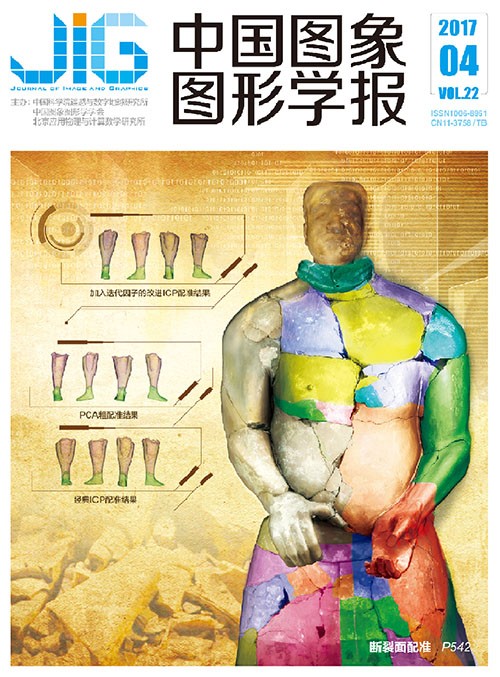
利用多级弦长拱高复函数进行面实体综合相似性度量研究
摘 要
目的 全球最高30 m分辨率的地表覆盖数据GlobeLand30具有高分辨率、高精度等特性,为全球制图提供了重要的数据来源。如何快速准确地识别GlobeLand30与矢量数据中的同名实体,对于空间数据的更新、集成与融合具有重要的意义,针对当前该数据与矢量数据匹配识别方法存在的不足,本文提出一种新的综合相似性度量方法。方法 利用面实体轮廓线的多级弦长、拱高和中心距离等特性,构造多级弦长拱高复函数对其整体和细节特征进行描述;然后对面实体轮廓线进行等间隔重采样,通过快速傅里叶变换得到傅里叶描述子对面实体间的形状相似性进行度量;最后将面实体的位置、大小、方向和形状进行加权综合,得到一种综合相似性度量模型。结果 将本文综合相似性度量模型应用到GlobeLand30与矢量数据面状水体的匹配中,实验结果为查准率P为100%,查全率Q为97.1%,匹配速度和准确率优于其他文献所提出的方法,当拱高级数为4时,匹配效果达到最优;最后,将该相似性度量模型应用到GlobeLand30数据化简和光滑前后的相似性度量上,也取得了很好的应用效果。结论 本文方法适用于GlobeLand30与矢量数据的相似性度量,对于GlobeLand30与矢量数据的集成与融合,对利用GlobeLand30进行矢量数据的生产与更新具有重要的意义。
关键词
Measurement of the comprehensive similarity of area entities using a multilevel arc-height complex function
Ma Jingzhen, Sun Qun, Xiao Qiang, Zhao Guocheng, Zhou Zhao(Information Engineering University, Zhengzhou 450001, China) Abstract
Objective Global land cover and its change are indispensable basic information for environmental change research, detection of national geographical conditions, and sustainable development. In 2014, the National Geomatics Center of China produced GlobeLand30, a remote sensing mapping product with the highest resolution (30 m) in the world. This data set exhibits high resolution and high accuracy, and thus, it can satisfy the cartographic requirement of 1∶250 000 and other smaller measuring scales as well as provide global data production and updating with significant data resources. When the difference between GlobeLand30 and vector data is considered, accurately and rapidly recognizing identical entities from these two types of data is highly important to update information as well as integrate and fuse multisource and multiscale spatial data. To overcome the shortcomings of the method for recognizing and matching GlobeLand30 and vector data, this study proposes a complex function based on a multilevel arc-height. Fourier shape descriptors can be obtained to measure shape similarity among area entities, and a comprehensive similarity measurement model can be established by integrating the location, size, direction, and shape of area entities. This study uses the proposed model to recognize and match GlobeLand30 and vector data as well as to measure the similarity of Globeland30 before and after simplification and smoothing. Method This method constructs a complex function based on multilevel chord length to describe the entire and detailed features of area entities by using the characteristics of their border, such as arc-height and central distance. After resampling the border of area entities, a shape descriptor with an independent and compact initial point on the border can be established through fast Fourier transform, which exhibits invariant properties in terms of translation, rotation, and scaling to measure shape similarity and diversity among area entities. Lastly, a comprehensive similarity measuring model is established by integrating the location, size, direction, and shape of area entities. GlobeLand30 and vector data are processed, and the similarity of the entities of these two types of data is calculated through the comprehensive similarity measuring model. Then, the specific entity is determined according to the set comprehensive spatial similarity threshold value. The rule for maintaining similarity by applying the proposed comprehensive similarity measuring model is discussed to measure the shape similarity and comprehensive similarity of Globeland30 data before and after applying different simplification and smoothing algorithms. Result This study selects the water data of Globeland30 (2010) as example and uses the proposed model to match them with another vector data after vectorization. Experimental results obtained a precision ratio of 100% and a recall ratio of 97.01%. The experiment, which is conducted to compare the method proposed in this study with others, shows that the method for describing tortuosity can only describe the entire, but not the detailed features. The description of similarity via central distance instead of Fourier shape descriptors increases the difference in similarity, which will result in omitting matching or other mistakes. The discussion regarding the effect of different arc-height levels proves that both matching precision ratio and recall ratio reach their maximum values when t is set to 4 or 8. Computation complexity is positively related to the value of t, and thus, matching speed will be lower if t is set higher. Moreover, setting t to 4 is better to achieve satisfying efficiency and accuracy. The point_remove or bend_simplify algorithms are applied to simplify different threshold values, whereas the peak or Bezier algorithm was selected for smoothing. The similarity measuring method is then applied to Globeland30 data before and after simplification and smoothing. From the results, we discuss the relation among similarity levels and threshold values. The findings of the experiment show that the two simplification algorithms can maintain approximately the same similarity when threshold values vary within a small range. However, variations outside the specific range will result in an evident difference that is reflected in the sharp corner phenomenon simplified by the point_remove algorithm. For the two smoothing algorithms, Bezier provides only one result, whereas the processing results of peak vary with different threshold values. Conclusion 1) This method constructs the multilevel chord length complex function to describe the entire and detailed features of area entities by using the characteristics of their border, such as multilevel chord length, arc-height, and central distance. This complex function satisfies the demand for multilevel shape description by changing arc-height level, including describing the entire and detailed features of area entities. The Fourier transform of the multilevel chord length complex function solves the inconsistencies in border and initial numbers of points, thereby meeting the demand for invariance in terms of translation, rotation, and scaling. 2) A comprehensive similarity measuring model is established based on the multilevel arc-height Fourier shape description method by integrating the location, size, direction, and shape of area entities. Experiments prove that this model works efficiently when matching two types of data. This study discusses the rule of maintaining similarity through different simplification and smoothing algorithms and by applying the similarity measuring method to evaluate the similarity of Globeland30 data before and after simplification and smoothing. The study achieves good results. It uses the water data as example and focuses on matching the entities of Globeland30 with another vector data by applying the comprehensive similarity measuring model. Further studies will focus more on the problem of matching Globeland30 data with other vector data and applying the results to produce and update vector data, particularly of overseas regions worldwide.
Keywords
Globeland30 complex function of multilevel arc-height fourier description similarity measuring area matching
|



 中国图象图形学报 │ 京ICP备05080539号-4 │ 本系统由
中国图象图形学报 │ 京ICP备05080539号-4 │ 本系统由